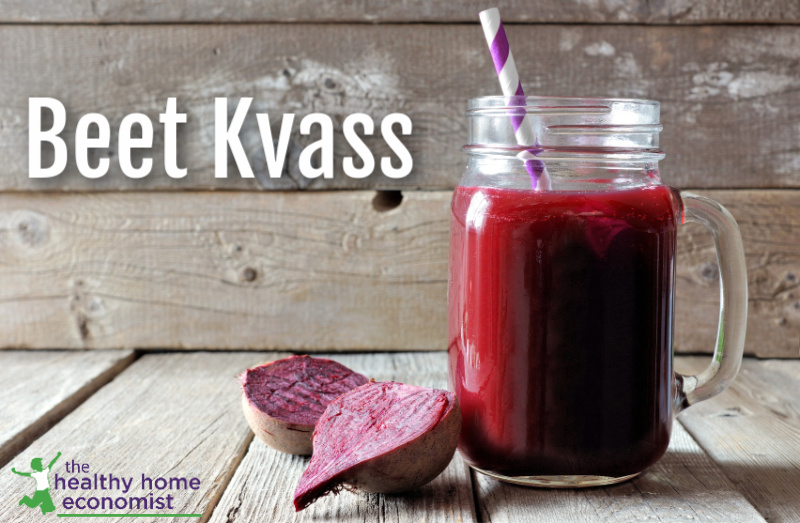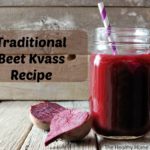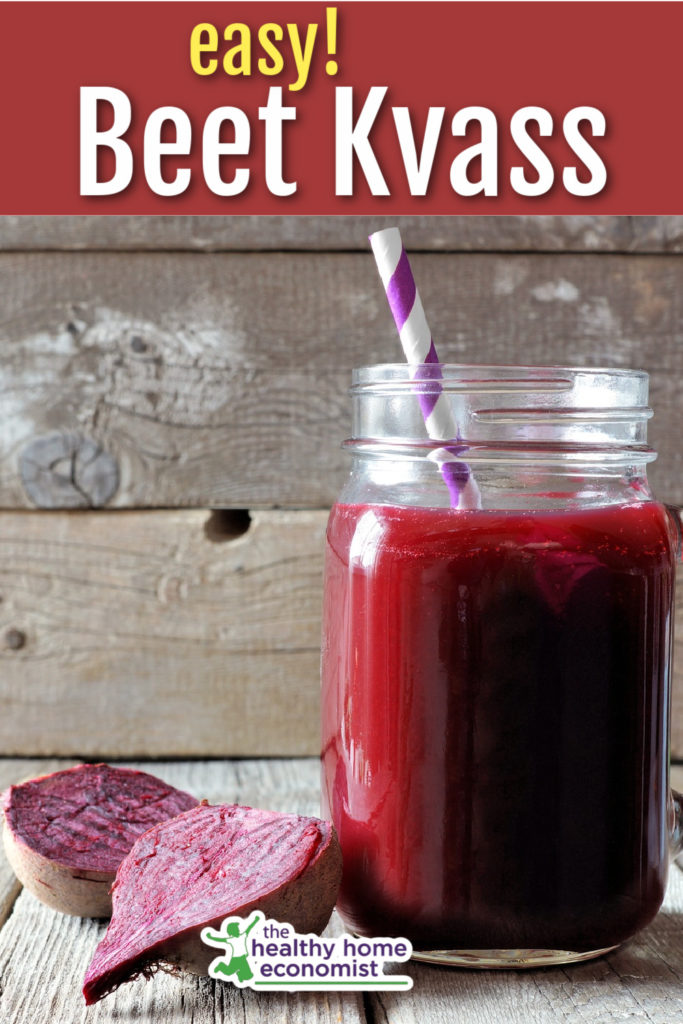Table of Contents[Hide][Show]
Beet kvass is potent, nutrient-rich tonic made by fermenting beets. It is essentially a DIY liquid multivitamin and more effective than taking brands from the store that contain synthetics!

One of the most nutritious and health-boosting fermented beverages you can make in your home is beet kvass. Beets are chock full of vitamins and minerals. Fermenting them supercharges nutrient levels even further and enhances absorption potential.
This ancestral tonic is extremely beneficial to those with any sort of digestive complaints.
In addition, beets are highly cleansing, so those with liver issues benefit from consuming beet kvass on a regular basis.
There isn’t another fermented drink that can improve health as rapidly in my personal experience.
Beet Kvass: DIY Liquid Multivitamin!
As a tonic, beet kvass is recommended first thing in the morning and after your evening meal.
Just 4 ounces or so is all you need to sip.
This highly nutritious superfood is far better than taking a multivitamin loaded with synthetic vitamins like folic acid.
I’m sipping a morning glass of beet kvass as I type this! What a great way to start the day and rev up your digestion each morning!
The recipe below was adapted from Nourishing Traditions Cookbook.
Most people make kvass with red beets. For a slightly sweeter and less earthy flavor, try making golden beet kvass.
If you find the results a bit salty, reduce the sea salt in the recipe to your liking.

Beet Kvass Recipe
Traditional beet kvass recipe that is an unbeatable morning and evening tonic for rapidly boosting health.
Ingredients
- 1-2 beets (1 large or 2 medium) preferably organic, tops removed
- filtered water
- 2 Tbl liquid whey
- 1/2 Tbl sea salt
Instructions
-
Wash beets thoroughly and slice into chunks no smaller than about 1/2 inch across. Feel free to peel the beets if desired; doing so reduces chances for mold on the ferment.
-
Put beet chunks into a clean, one-quart mason jar. Add whey, sea salt, and enough filtered water to fill all but 1 inch from the top of the jar. Stir and mix well. Close the lid and leave on the kitchen counter for 1-2 days. Try to keep it away from the fruit bowl to discourage the growth of mold.
-
Drink as desired and refrigerate once the fermentation period is complete. A 4 ounce glass morning and evening is recommended.
-
When an inch or so of beet kvass liquid is left in the jar, refill with more filtered water, stir, and close the lid again and leave on the counter for 2 days more. Refrigerate fresh batch of beet kvass and drink as desired.
-
When all the liquid is used up from the second batch, discard or compost the beets and start the process again.
Recipe Video
Recipe Notes
If the beet kvass is too salty for you, feel free to reduce the salt to 1/4 tablespoon for your next batch.
White fuzzy bubbles forming on the top of the liquid is normal and fine as the fermentation progresses.

More Fermented Drink Recipes to Enjoy
How to Make Fermented Lemonade
Orangina Recipe (Fermented Orange Juice)
How to Make Kombucha








Great Videos, thank you for sharing.
Can I use white, golden or striped beets or must they be RED BEETS?
Cathy
I made the kvass and tried some last night and this morning. I don't find the flavor or scent very strong at all (salty, yes!). But people saying they found it hard to swallow makes me wonder if I did something wrong. Is it supposed to be strong-flavored?
I also have found the taste of beet kvass hard to 'swallow'. But I LOVE beets! Here's what I did with my kvass:
http://tntkell.typepad.com/keepitreal/2009/11/beet-kvass-kefir-smoothie.html
Hi Lisa, I don't see why it would be a problem to feed the beets to the chickens. Please check back and let us know if they eat them or not!
Hi Sarah,
What are you thoughts on feeding the beets to my laying hens after the second batch? I don't even know if they'd eat them but they like other vegetables.
Hi Ruth, thanks for commenting! My copy of the book "Juicing for Life" contains a recipe where the juice of beets is considered a liver tonic. Fermenting them could only be more beneficial then as lactofermenting adds probiotics and increases nutrient value (example: saurkraut has substantial vitamin C but regular cabbage does not).
Hi, Sarah. This is anonymous of June 17, 2010 9:35 AM again (Ruth, actually).
You say that beet kvass is a good liver tonic among other things. I did a thorough search of the internet, looking for comments on blogs, forums, whatever, of people reporting improvements in their health after taking beet kvass. I didn't really find any.
Let me just say that I'm totally in favour of traditional foods, Weston Price etc., but I'm going to play devil's advocate for a sec.
It seems to me that Sally Fallon made certain statements about the kvass, and others repeated them, and so it goes around the WAP blogs. I don't expect to find a scientific study on the topic (who would fund it?) but a bunch of people writing in to say they felt better after adding it their diet would go a long way to convince me that it's as good as they say.
I don't have nourishing traditions, so I don't know if Sally Fallon offers any evidence.
So, can anyone report of feeling healthier by adding this tonic to their diet? Thoughts Sarah or anyone else?
On the flip side, I don't see how it could hurt. Beets=healthy. Fermenting=good.
For children, only 1-2 oz of beet kvass are needed. You may have a little trouble getting it into them. Stirring it into a soup (not too hot) might be a good option for them instead of drinking straight from a glass.
Hi Alina, it's hard to judge what exactly is optimal. I think the idea is to ferment it adequately so that the nutritional benefits are achieved. There is so much variation by location, time of year etc .. you will find your fermentation time is all over the board after you do this for awhile. It really is an art! Just try to get it fermented adequately based on what I show you in the videos and then adjust to your tastes and preferences for the strength of the flavor over time as you gain experience for how things brew in your particular home.
Hi Naomi, I look for a little line of white bubbles on the top and when this goes on for about 24 hours its done. With mine kvass in the video, the bubbles started right away, so it only took about 24 hours before it was fermented enough. I might have been able to leave it longer, but didn't want to risk mold as warm as the house is right now.
I doubt the salt in my kvass was completely dissolved. I stir it, but don't worry if not completely dissolved. I haven't had a problem there as the kvass tastes quite salty so enough must be dissolved to ferment at least. I would use Celtic salt as there are more minerals than RealSalt and I think the resulting flavor is better with celtic.
Yes, the beets lose some color and the second ferment is not as beet red as the first. It also won't taste quite as strong. This is normal and not a problem.